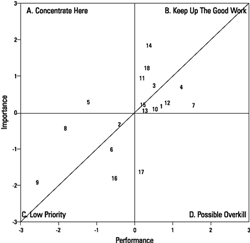HOW TO IMPROVE ONESELF IN THE PERSPECTIVE OF QUALITY
How to apply continuous improvement
Characters: small | medium | big
Asaaki Imai has suggested that the foremost concern of a kaizen (continuous improvement) strategy should be the quality of people.
Quality professionals apply quality management techniques to their work, but what about to themselves? A person is both a product and a process and, as such, can be improved.
In addition to creating quality in the workplace, your goal can also be to become a quality person.
Recent articles on personal quality have suggested to use total quality management techniques to improve personal performance. The personal improvement method proposed applies an iterative improvement process—or modified plan-do-check-act cycle—consisting of five steps.
Step 1: Determine what is important
Quality is defined as what is important from the customer’s viewpoint. But who is the customer when you are improving yourself? You are. To achieve your personal goals, you will have to satisfy other customers (such as your employer), but you are the primary customer because you know best what kind of person you want to be.
Two methods can help determine what is important to yourself and others. They are often useful when you are unsure about what is important or when what you do doesn’t match what you say. For example, customers say they want the highest quality statistical analysis, but their actions indicate what they actually want is adequate analysis delivered quickly.
The first method is direct measurements of importance. To identify these measurements, make a list of what is important to you and rank the items from the most important to the least.
The second method is inferred measurements of importance, which are usually based on overall reactions or on behavior. One theory in social psychology the self-perception theory—argues that people do not directly know what they want but have to infer it from their behavior. For example, career counselors sometimes find that people are confused about the kinds of careers they want. Too often, people respond to social pressure about what others think they should want. Thus, a standard career counseling method is to have people list past jobs and activities that they liked and didn’t like. Then, they infer what they truly want by analyzing their past behaviors.
Step 2: Determine how you perform
Once you know what is important, the next step is to determine whether you are doing what is important. The importance of an attribute vs. its performance can be visualized with a method called importance-performance analysis in witch:

- Quadrant I is the “keep it up” quadrant. It contains the areas that are important to the job and the employee, and the employee is currently proficient in those areas
- Quadrant II is the “wake-up call” quadrant. It contains the areas that need focus because they are important to the job and the employee, but the employee is not proficient in them
- Quadrant III is the “forget it” quadrant. It contains the areas that are of no value to the employee or the job
- Quadrant IV is the “possible overdoing” quadrant. It contains areas in which the employee is proficient but are of little value to the job
Step 3: Develop improvement projects
When developing improvement projects, remember this rule: You can’t do it all. About 80% of the benefits will come from completing about 20% of the projects. An effort-payoff analysis can help you choose which improvement projects are most worthwhile.
In the effort-payoff analysis, the expected payoff is plotted against the investment of time and effort needed to achieve that payoff.
The effort-payoff analysis plot has four quadrants also:
- Quadrant I contains high-effort, high-payoff projects.
- Quadrant II contains low-effort, high-payoff projects. The main focus should be on this “easy work, big reward” quadrant.
- Quadrant III contains low-effort, low-payoff projects. While some of these small, easy projects might be worth doing, people sometimes get stuck in this quadrant, doing easy projects with limited value. These projects should be fit into spare time
- Quadrant IV contains high-effort, low-payoff projects, or “misguided” projects.
Based on this analysis, the employee made a list of projects to complete.
Step 4: Break projects into manageable parts and reward completion
When faced with a large task, how do you start? If a significant self-improvement seems such a large task that you might wonder whether it’s worth it, just remember this Chines proverb: A journey of a 1,000 miles begins with a single step.
Just as a long journey must be broken into shorter, daily journeys with rewards and rests, so must the difficult project be subdivided into a series of smaller, easier projects.
Personal improvement is hard work. There is short-term pain for long-term gain. How can you endure the short-term pain so that the long-term gain can be realized? One way is to reward the short-term improvements that will lead to the long-term gains.
Step 5: Track improvement and re-evaluate regularly
The idea of applying quality-control tracking to personal improvement is not new. For example, 20 years ago John M. Gottman and Sandra R. Leiblum proposed using Shewhart charts to monitor progress in psychotherapy.
It is important to track improvement regularly because it helps you see your progress. Sometimes progress can be slow enough that you might not notice it. When you go back to a list of potential projects from a few months back, however, you might be surprised at how much you have accomplished.
